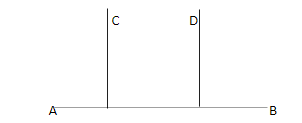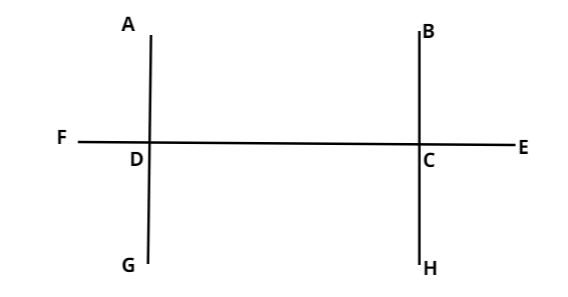
State true or false:
Two lines perpendicular to the same line are perpendicular to each other:
(A) True
(B) False
Answer
492k+ views
1 likes
Hint: Two lines are said to be perpendicular to each other if an angle ofis formed between them. If two lines are perpendicular to the same line a figure will be formed

But these two lines do not seem to be perpendicular to each other. Many lines can be perpendicular to the same line. But those are perpendicular to each other that’s not necessary. We can apply the concept of interior alternate angles, corresponding angles. Alternate angles are between the two lines intersected by the transversal they form a Z shape. When two lines are crossed by another line (which is called transversal), the angles in matching corners are called corresponding angles.
Complete step-by-step answer:
Step1: To prove this we may take any figure in which two lines are perpendicular to each other
Let us take a figure in which line AG is perpendicular to FE and line BH is perpendicular to FE

Both the lines are perpendicular to the same line
Step2: From the given figure
This can only be possible when the line
Hence option (B) is correct answer statement is false
Note: We can here also prove the lines parallel by:
The sum of co-interior angles are. They lies on the same side of transversal between the two lines
In the above figure the pair of angles that form co-interior angles are
This can only be possible when lines are parallel then the sum of co-interior angles between them are supplementary.
Hence by this also it proves that lines are not perpendicular they are parallel

But these two lines do not seem to be perpendicular to each other. Many lines can be perpendicular to the same line. But those are perpendicular to each other that’s not necessary. We can apply the concept of interior alternate angles, corresponding angles. Alternate angles are between the two lines intersected by the transversal they form a Z shape. When two lines are crossed by another line (which is called transversal), the angles in matching corners are called corresponding angles.
Complete step-by-step answer:
Step1: To prove this we may take any figure in which two lines are perpendicular to each other
Let us take a figure in which line AG is perpendicular to FE and line BH is perpendicular to FE

Both the lines are perpendicular to the same line
Step2: From the given figure
This can only be possible when the line
Hence option (B) is correct answer statement is false
Note: We can here also prove the lines parallel by:
The sum of co-interior angles are. They lies on the same side of transversal between the two lines
In the above figure the pair of angles that form co-interior angles are
This can only be possible when lines are parallel then the sum of co-interior angles between them are supplementary.
Hence by this also it proves that lines are not perpendicular they are parallel
Latest Vedantu courses for you
Grade 8 | CBSE | SCHOOL | English
Vedantu 8 CBSE Pro Course - (2025-26)
School Full course for CBSE students
₹45,300 per year
Recently Updated Pages
Express the following as a fraction and simplify a class 7 maths CBSE

The length and width of a rectangle are in ratio of class 7 maths CBSE

The ratio of the income to the expenditure of a family class 7 maths CBSE

How do you write 025 million in scientific notatio class 7 maths CBSE

How do you convert 295 meters per second to kilometers class 7 maths CBSE

Write the following in Roman numerals 25819 class 7 maths CBSE

Trending doubts
Fill the blanks with the suitable prepositions 1 The class 9 english CBSE

Difference Between Plant Cell and Animal Cell

Given that HCF 306 657 9 find the LCM 306 657 class 9 maths CBSE

The highest mountain peak in India is A Kanchenjunga class 9 social science CBSE

What is the difference between Atleast and Atmost in class 9 maths CBSE

What is pollution? How many types of pollution? Define it





